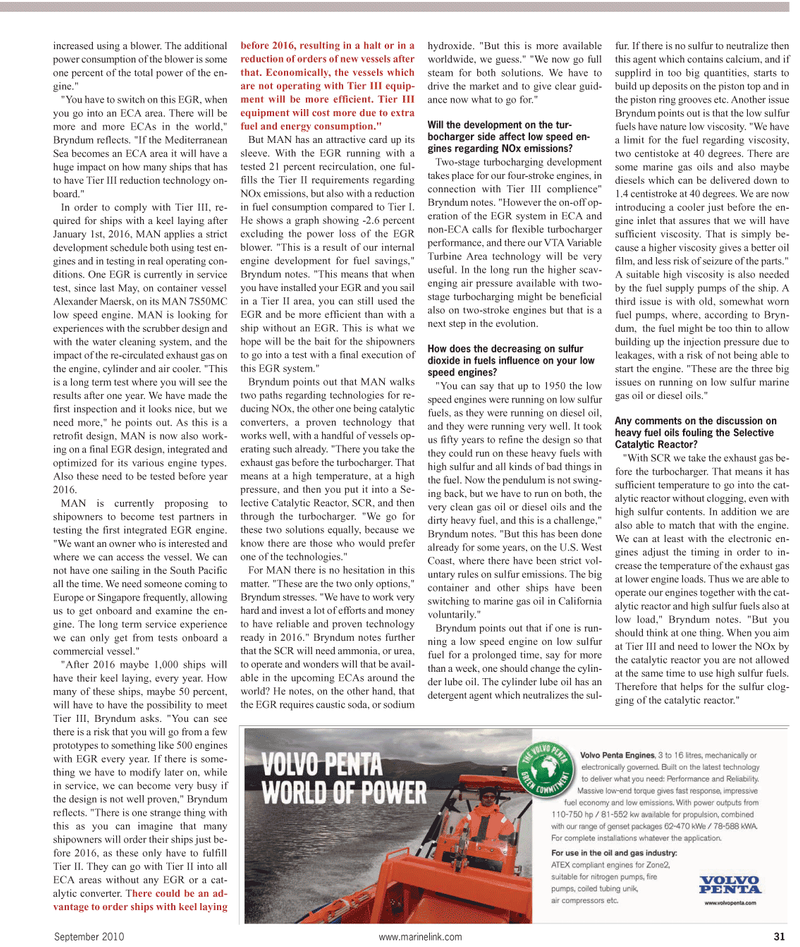
Page 31: of Maritime Reporter Magazine (September 2010)
Marine Propulsion Edition
Read this page in Pdf, Flash or Html5 edition of September 2010 Maritime Reporter Magazine
increased using a blower. The additional power consumption of the blower is some one percent of the total power of the en- gine." "You have to switch on this EGR, when you go into an ECA area. There will be more and more ECAs in the world,"
Bryndum reflects. "If the Mediterranean
Sea becomes an ECA area it will have a huge impact on how many ships that has to have Tier III reduction technology on- board."
In order to comply with Tier III, re- quired for ships with a keel laying after
January 1st, 2016, MAN applies a strict development schedule both using test en- gines and in testing in real operating con- ditions. One EGR is currently in service test, since last May, on container vessel
Alexander Maersk, on its MAN 7S50MC low speed engine. MAN is looking for experiences with the scrubber design and with the water cleaning system, and the impact of the re-circulated exhaust gas on the engine, cylinder and air cooler. "This is a long term test where you will see the results after one year. We have made the first inspection and it looks nice, but we need more," he points out. As this is a retrofit design, MAN is now also work- ing on a final EGR design, integrated and optimized for its various engine types.
Also these need to be tested before year 2016.
MAN is currently proposing to shipowners to become test partners in testing the first integrated EGR engine. "We want an owner who is interested and where we can access the vessel. We can not have one sailing in the South Pacific all the time. We need someone coming to
Europe or Singapore frequently, allowing us to get onboard and examine the en- gine. The long term service experience we can only get from tests onboard a commercial vessel." "After 2016 maybe 1,000 ships will have their keel laying, every year. How many of these ships, maybe 50 percent, will have to have the possibility to meet
Tier III, Bryndum asks. "You can see there is a risk that you will go from a few prototypes to something like 500 engines with EGR every year. If there is some- thing we have to modify later on, while in service, we can become very busy if the design is not well proven," Bryndum reflects. "There is one strange thing with this as you can imagine that many shipowners will order their ships just be- fore 2016, as these only have to fulfill
Tier II. They can go with Tier II into all
ECA areas without any EGR or a cat- alytic converter. There could be an ad- vantage to order ships with keel laying before 2016, resulting in a halt or in a reduction of orders of new vessels after that. Economically, the vessels which are not operating with Tier III equip- ment will be more efficient. Tier III equipment will cost more due to extra fuel and energy consumption."
But MAN has an attractive card up its sleeve. With the EGR running with a tested 21 percent recirculation, one ful- fills the Tier II requirements regarding
NOx emissions, but also with a reduction in fuel consumption compared to Tier I.
He shows a graph showing -2.6 percent excluding the power loss of the EGR blower. "This is a result of our internal engine development for fuel savings,"
Bryndum notes. "This means that when you have installed your EGR and you sail in a Tier II area, you can still used the
EGR and be more efficient than with a ship without an EGR. This is what we hope will be the bait for the shipowners to go into a test with a final execution of this EGR system."
Bryndum points out that MAN walks two paths regarding technologies for re- ducing NOx, the other one being catalytic converters, a proven technology that works well, with a handful of vessels op- erating such already. "There you take the exhaust gas before the turbocharger. That means at a high temperature, at a high pressure, and then you put it into a Se- lective Catalytic Reactor, SCR, and then through the turbocharger. "We go for these two solutions equally, because we know there are those who would prefer one of the technologies."
For MAN there is no hesitation in this matter. "These are the two only options,"
Bryndum stresses. "We have to work very hard and invest a lot of efforts and money to have reliable and proven technology ready in 2016." Bryndum notes further that the SCR will need ammonia, or urea, to operate and wonders will that be avail- able in the upcoming ECAs around the world? He notes, on the other hand, that the EGR requires caustic soda, or sodium hydroxide. "But this is more available worldwide, we guess." "We now go full steam for both solutions. We have to drive the market and to give clear guid- ance now what to go for."
Will the development on the tur- bocharger side affect low speed en- gines regarding NOx emissions?
Two-stage turbocharging development takes place for our four-stroke engines, in connection with Tier III complience"
Bryndum notes. "However the on-off op- eration of the EGR system in ECA and non-ECA calls for flexible turbocharger performance, and there our VTA Variable
Turbine Area technology will be very useful. In the long run the higher scav- enging air pressure available with two- stage turbocharging might be beneficial also on two-stroke engines but that is a next step in the evolution.
How does the decreasing on sulfur dioxide in fuels influence on your low speed engines? "You can say that up to 1950 the low speed engines were running on low sulfur fuels, as they were running on diesel oil, and they were running very well. It took us fifty years to refine the design so that they could run on these heavy fuels with high sulfur and all kinds of bad things in the fuel. Now the pendulum is not swing- ing back, but we have to run on both, the very clean gas oil or diesel oils and the dirty heavy fuel, and this is a challenge,"
Bryndum notes. "But this has been done already for some years, on the U.S. West
Coast, where there have been strict vol- untary rules on sulfur emissions. The big container and other ships have been switching to marine gas oil in California voluntarily."
Bryndum points out that if one is run- ning a low speed engine on low sulfur fuel for a prolonged time, say for more than a week, one should change the cylin- der lube oil. The cylinder lube oil has an detergent agent which neutralizes the sul- fur. If there is no sulfur to neutralize then this agent which contains calcium, and if supplird in too big quantities, starts to build up deposits on the piston top and in the piston ring grooves etc. Another issue
Bryndum points out is that the low sulfur fuels have nature low viscosity. "We have a limit for the fuel regarding viscosity, two centistoke at 40 degrees. There are some marine gas oils and also maybe diesels which can be delivered down to 1.4 centistroke at 40 degrees. We are now introducing a cooler just before the en- gine inlet that assures that we will have sufficient viscosity. That is simply be- cause a higher viscosity gives a better oil film, and less risk of seizure of the parts."
A suitable high viscosity is also needed by the fuel supply pumps of the ship. A third issue is with old, somewhat worn fuel pumps, where, according to Bryn- dum, the fuel might be too thin to allow building up the injection pressure due to leakages, with a risk of not being able to start the engine. "These are the three big issues on running on low sulfur marine gas oil or diesel oils."
Any comments on the discussion on heavy fuel oils fouling the Selective
Catalytic Reactor? "With SCR we take the exhaust gas be- fore the turbocharger. That means it has sufficient temperature to go into the cat- alytic reactor without clogging, even with high sulfur contents. In addition we are also able to match that with the engine.
We can at least with the electronic en- gines adjust the timing in order to in- crease the temperature of the exhaust gas at lower engine loads. Thus we are able to operate our engines together with the cat- alytic reactor and high sulfur fuels also at low load," Bryndum notes. "But you should think at one thing. When you aim at Tier III and need to lower the NOx by the catalytic reactor you are not allowed at the same time to use high sulfur fuels.
Therefore that helps for the sulfur clog- ging of the catalytic reactor."
September 2010 www.marinelink.com 31

 30
30

 32
32
